40 MEASURES TO ENSURE ACCESSIBILITY
Total accessibility exists inside the Tram. The guidelines to ensure this began to be drawn up during the project phase, in conjunction with ONCE and the DFA Foundation, with an agreement reached establishing 40 measures.
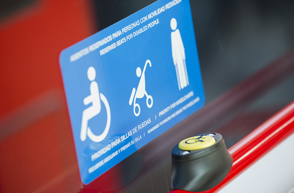
INSIDE THE TRAM
-
Everything at ground level
-
1. There is no gap between door and platform when accessing the carriages at the stops on Line 1.
-
2. At the double doors, the carriages have ramps which extend prior to the doors opening to ensure no 'gap' exists.
-
3. The single doors have a permanent footboard to achieve the same result. Full access for people with reduced mobility, as well as for people with prams or shopping carts.
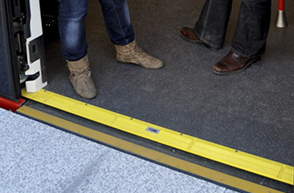
-
-
Yellow stripe on the floor to outline the doors
-
4. All of the Tram doors have a yellow stripe to indicate the border with the platform. These have grooves so they are easily detectable.
-
5. The double doors have a stripe on their central band which provides a contrast in the middle when the doors are closed.
-
6. The doors are a different colour from the rest of the vehicle.
-
-
The doors account for 20% of the length of the Tram
-
7. The Tram has 6 doors on either side, 4 of them double, to ensure smooth transit.
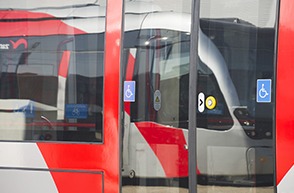
-
-
Non-slip flooring to prevent falls
-
8. The floor has a layer of granular rubber to prevent falls, particularly when it is raining or snowing.
-
-
Red handholds provide strong colour contrast
-
9. In the design, there are up to 30 colour contrast points for people who are visually impaired.
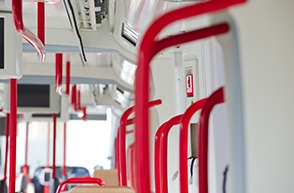
-
-
Location of ticket machines
-
10. The ticket machines are held in place by rails in a 'Y' shape and thus are easy for the blind to find using their canes.
-
11. The handholds have closed ends and at the doorways are bent round.
-
12. Their placement allows a person to move from the front to the back of the Tram, while always being able to hold on to a handhold.
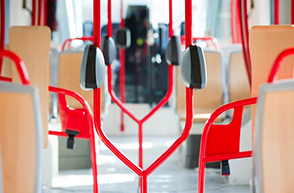
-
-
Removal of sharp edges
-
13. All sharp edges have been eliminated so as not to hamper wheelchairs or people with reduced mobility.
-
-
Information for the passenger is given in 'Verdana' font
-
14. Texts are written in lower case (in accordance with ONCE specifications) so as to be easier to read.
-
15. The 'Verdana' font was chosen because of the simplicity of its form.
-
16. All messages are printed in colours that are clearly contrasted and of an easily readable size.
-
-
Four areas reserved and indicated in each Tram for wheelchairs
-
17. The spaces for the wheelchairs are in carriages 2 and 4 (there are 5); they are clearly indicated both on the inside and on the outside.
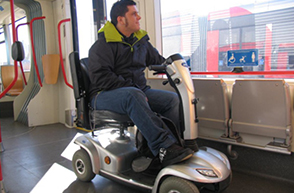
-
18. Each of these spaces has a seatbelt.
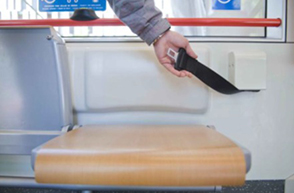
-
19. There is a call button at the right height for people in wheelchairs. Once pressed, this tells the driver that a person in a wheelchair wishes to leave the Tram.
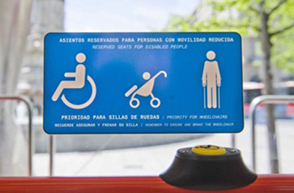
-
-
16 seats reserved and indicated for people with reduced mobility
-
20. In addition to the four wheelchair spaces, each vehicle has a further 16 seats reserved and indicated for people with reduced mobility. These seats are those closest to the doors.
-
21. There is a call button that warns the driver when a person with reduced mobility wishes to get out.
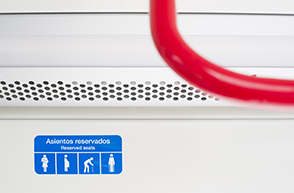
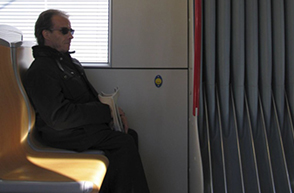
-
-
Four seats with ischiatic support
-
22. In carriages 2 and 4 , there are seats with an ischiatic support (next to the doors) - vertical wooden elements to support the back. They are for people who cannot sit on a conventional seat.
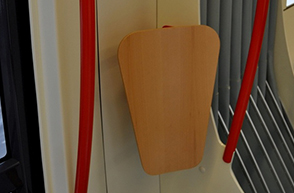
-
-
Each stop is announced over the tannoy
-
23. In the tram, all stops are announced prior to arrival.
-
-
AT THE SHELTERS
-
Tactile yellow safety area on the platform
-
24. The yellow paving chosen features a type of tactile cylinder which prevents wheelchairs from getting stuck.

-
-
Large-font information for passengers
-
25. The text at the stop is written in lower case (in accordance with ONCE specifications) so as to be easier to read.
-
-
Seats with ischiatic support
-
26. The stop has a bench which features an area with ischiatic support.

-
-
Accessible ticket machines
-
27. Contrasting colours have been chosen and the ticket machines have an on-screen option for people with reduced sight.
-
28. Push a button to access this mode and the letters are enlarged. All on-screen instructions also have a voice option.
-
29. All of the functions have text in Braille. Also, pressing the 'i' button puts you in direct contact with an operator through the intercom system.
-
30. The operator can perform the task requested by the user directly from the control centre.
-
31. The ticket machine area has tactile paving so that the blind can find it easily.
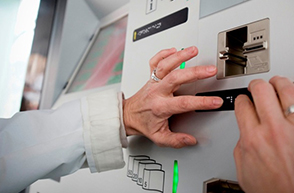
-
-
Tannoy at the stops
-
32. All of the stops have a tannoy system to communicate any incident that might happen at a stop. The sound has been set in accordance with ONCE specifications.
-
-
MEASURES FOR ACCESSIBILITY AND URBAN RENEWAL
-
Tactile paving at all the crossings
-
33. The cylinders have been chosen so as not to inconvenience the blind with their canes, prams or manually operated wheelchairs.
-
34. The paving has grooves which indicate the direction of the pavement to the blind.

-
-
Lowered curbs at all crossings
-
35. The curbs at all crossings - whether road or tramway - are lowered.
-
-
Pedestrian walkway from Plaza Emperador Carlos to Plaza Aragón
-
36. Prior to the urban renovation, the boulevard was criss-crossed in numerous places, meaning that pedestrians had to move off the walkway onto the pavements at the side of the road. Now the walkway runs for 1,730 metres to the heart of the city.
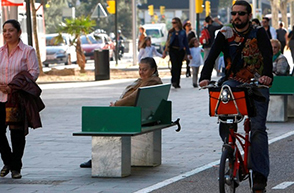
-
-
Traffic light with warning sound activated via Bluetooth
-
37. The activation of this app on your mobile means that when the device approaches a traffic light, it detects the light and activates the warning sound function so the blind person knows whether it is red or green.
-
38. This system also works with a specific device that ONCE provides its members.
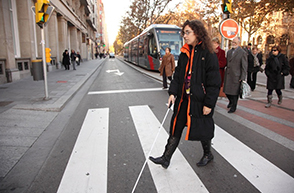
-
-
Slightly raised edge in Coso
-
39. In the pedestrianised section of Coso, a slightly elevated edge has been installed so that people with reduced sight can notice the distinction between pavement and tramway.
-
-
Intermediate areas with colour contrast and distinct paving
-
40. The intermediate areas between the tramways and the road have been painted in an orangey-red so that they can be seen by people with reduced sight. In addition the paving is different.

-